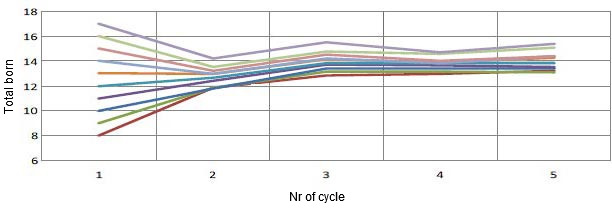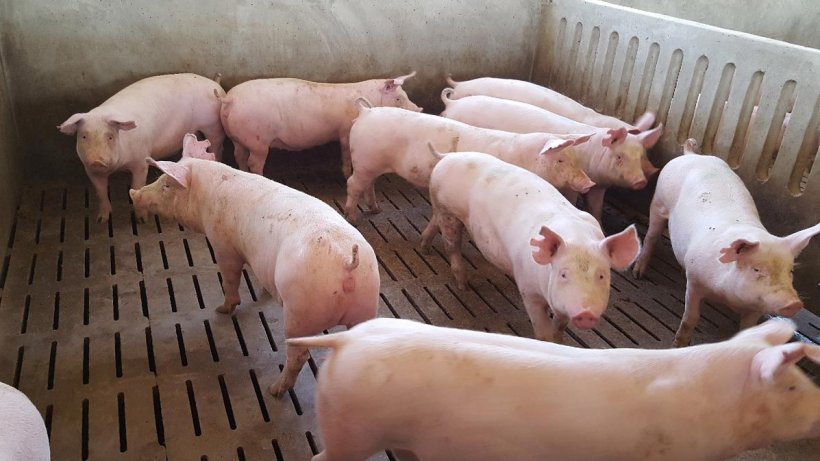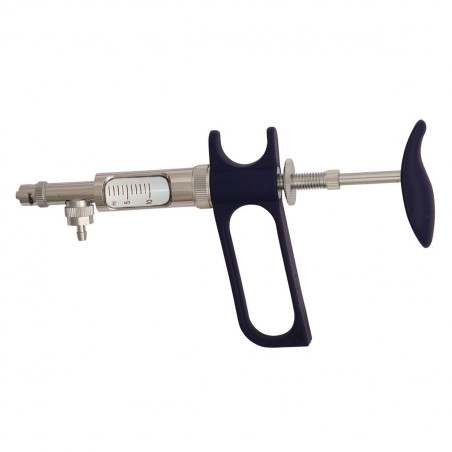Most modern farms have replacement rates of 45-50%. In a farm with a correct census structure, primiparous account for 20-24% of the productive census.
Their reproductive behaviour will depend on how those future breeding animals are introduced and acclimatised, but also and even more important, the health stability of the entire farm will also depend on these procedures.

Fertility and prolificacy of the first mating will depend directly on how this first mating is prepared, but it also has direct implications on the prolificacy of future parities (figure 1).

Graph 1. Evolution of prolificacy based on first farrowing prolificacy. For each piglet total born (TB) at the first farrowing, there will be 0.4 more TB per cycle.
What is done in this period will also have an impact, to a large extent, on the percentage of young sows losses, either by the need of an early culling or by mortality.
In two consecutive articles we will speak with two experts, Joan Aparicio and Lluís Ferrer, about the preparation of the gilts for their first mating.
The preparation includes, first of all, a health aspect to avoid that the future breeding animals are a source of problems for the farm, and they are acclimatised to the microbism present in the farm. On the other hand there is the productive side in which the focus is that the gilt reaches the first mating in the best conditions to have a good fertility and prolificacy.
This article is focused on the health area and the next will talk about the productive aspects.
What is the minimum time do you consider necessary to acclimatise the gilts?
Aparicio says that his preferred option would be to have 12 weeks between isolation-acclimation. However, in many farms there is not so much space. In any case, the minimum is 8 weeks. "Eight weeks are non-negotiable." Ferrer agrees with this minimum.

Photo 1. The gilt’s age on arrival determines the length of the available health acclimation period. Although as a rule of thumb, the longer the better, our experts determine that 8 weeks is the bare minimum time needed.
Ferrer also explains that to schedule the replacement of a farm, three basic questions must be asked first:
- Available space to introduce the future breeding gilts
- How is it distributed? One or several rooms?
- Size of the farm
Based on this, the replacement is distributed in age groups. He says: — "In small farms, the introduction of different age groups does not usually balance out. Nevertheless, in bigger farms, it is preferable to introduce 2 age groups (4-5 months of age)". Ferrer points out that, "although it might be interesting to introduce even younger animals from a health point of view, there is a factor that holds many owners back: the genetic premium is paid regardless of the age of the gilts and, therefore, losses are very expensive". In any case, 100 kg would be the maximum weight I would accept to be introduced, otherwise there is no time to acclimatise them without ending up with gilts that are too heavy.
Aparicio clarifies that a new farm, where all the buildings could be designed from scratch, would be another matter altogether. In this case, he would consider farms with internal replacement, to minimize the introduction of external animals as much as possible. Only a few purebred animals (GPs) twice a year to be able to produce gilts internally.
Objectives of the isolation-acclimation period
Aparicio is very clear in that, from a health point of view, this 8-12 week period has two different objectives:
- The isolation process: its main purpose is to check the health of the incoming animals; it must last at least 4 weeks.
- The period of acclimation ("infecting phase"), when future breeding animals are acclimatised to the germs present at the farm.
For him, these two functions require differentiated buildings. The quarantine barn must be a building clearly differentiated from the rest of the farm (photo 2), with independent access and use of exclusive clothing and materials. The quarantine is an isolation process where tests are carried out on arrival and 2-3 weeks later to confirm that the animals’ health status on arrival was the expected one. If this is not the case, the role of the quarantine is protecting the farm and preventing the introduction of unwanted diseases into the herd.

Photo 2. The role of the quarantine building is to protect the health of the farm. It must allow to "isolate" the new incoming animals until their health status has been checked. It must be as far as possible from the other farm buildings and it must be managed independently.
The main tasks in this period are health checks, clinical observation and the start of the vaccination program.
| Stages of health acclimation | ||
| Isolation building | Check health status | Minimum 4 weeks |
| Acclimation building | Acclimation-vaccination process | Minimum 4 weeks |
In the second phase, the acclimation/infecting phase, the vaccination program continues, and the animals are put in contact with infective material from the farm. For Aparicio, the most important point is digestive feedback. Depending on the farm and the diseases to be acclimatised to, other options may be considered: direct contact with culled sows or even afterbirths.
Both experts agree not to use direct infections with field PRRS virus.
Immunisation
It is one of the key factors of health acclimation. There is not a single vaccination protocol; it will depend on the health status of each farm.
However, the two experts agree that, in most Spanish farms, vaccination against PRRS with a live vaccine is essential. In fact, Ferrer affirms that this disease is the main factor in determining the length of the acclimation program.
For him, vaccination against circovirus and mycoplasma is also important for a good immunization of gilts, regardless of whether they were already vaccinated at the weaning stage. The other two vaccines that can never be missed are parvovirus and erysipelas. All other vaccines will depend on the health status of each farm.
Ferrer also states that, according to his experience, many farms make the mistake of carrying out a "massive gilt vaccination program" in too short a period of time, with one or several different vaccines every week for 3-4 consecutive weeks. In his opinion, a 2-week period should be observed between different vaccines to allow for a good immune response.
In essence, isolation-testing of incoming animals and infection-acclimation-vaccination are the essential components of a good health acclimation of gilts.
Without it, the productive acclimation will be a failure, no matter how well we do it, and it will be impossible to achieve health stability in the farm.






